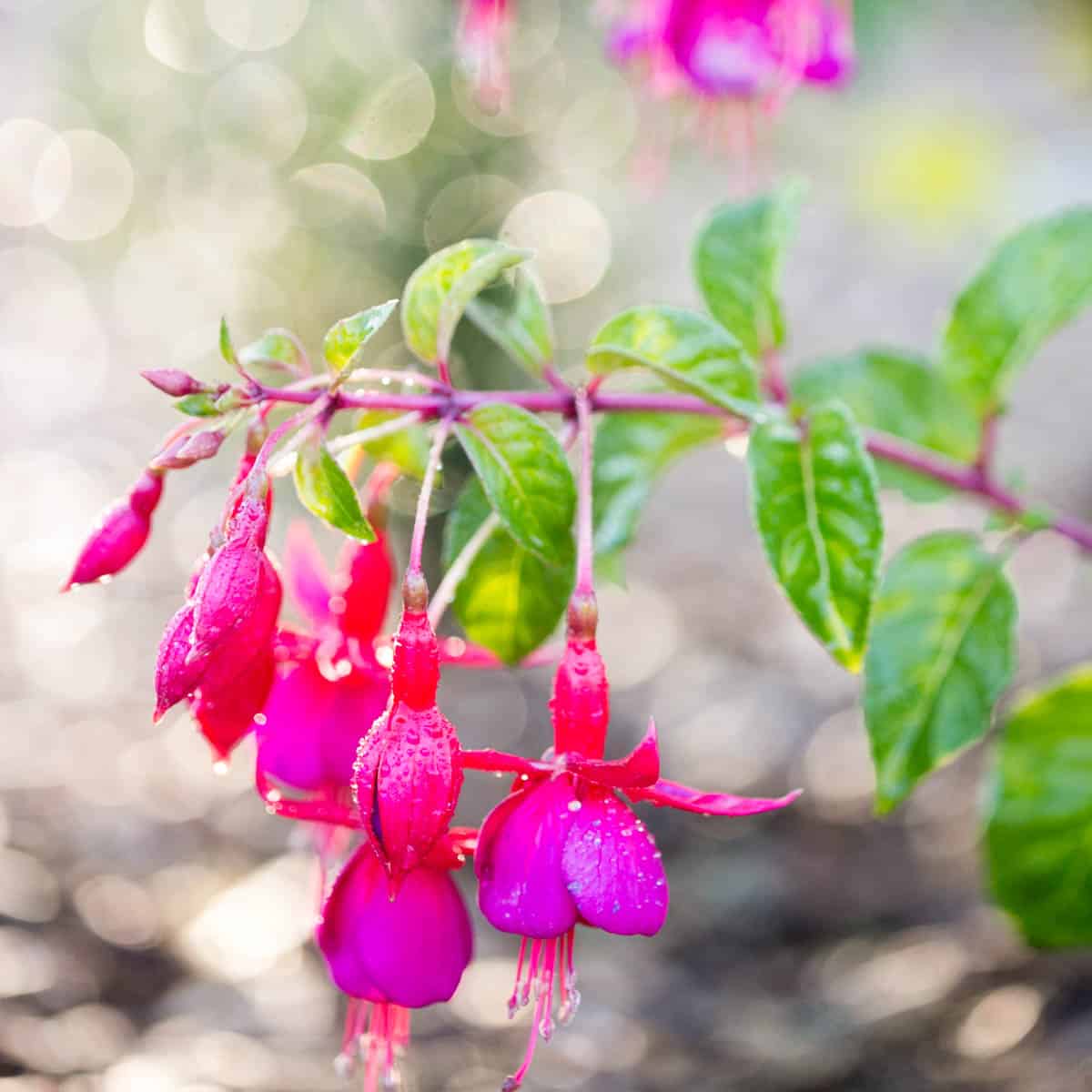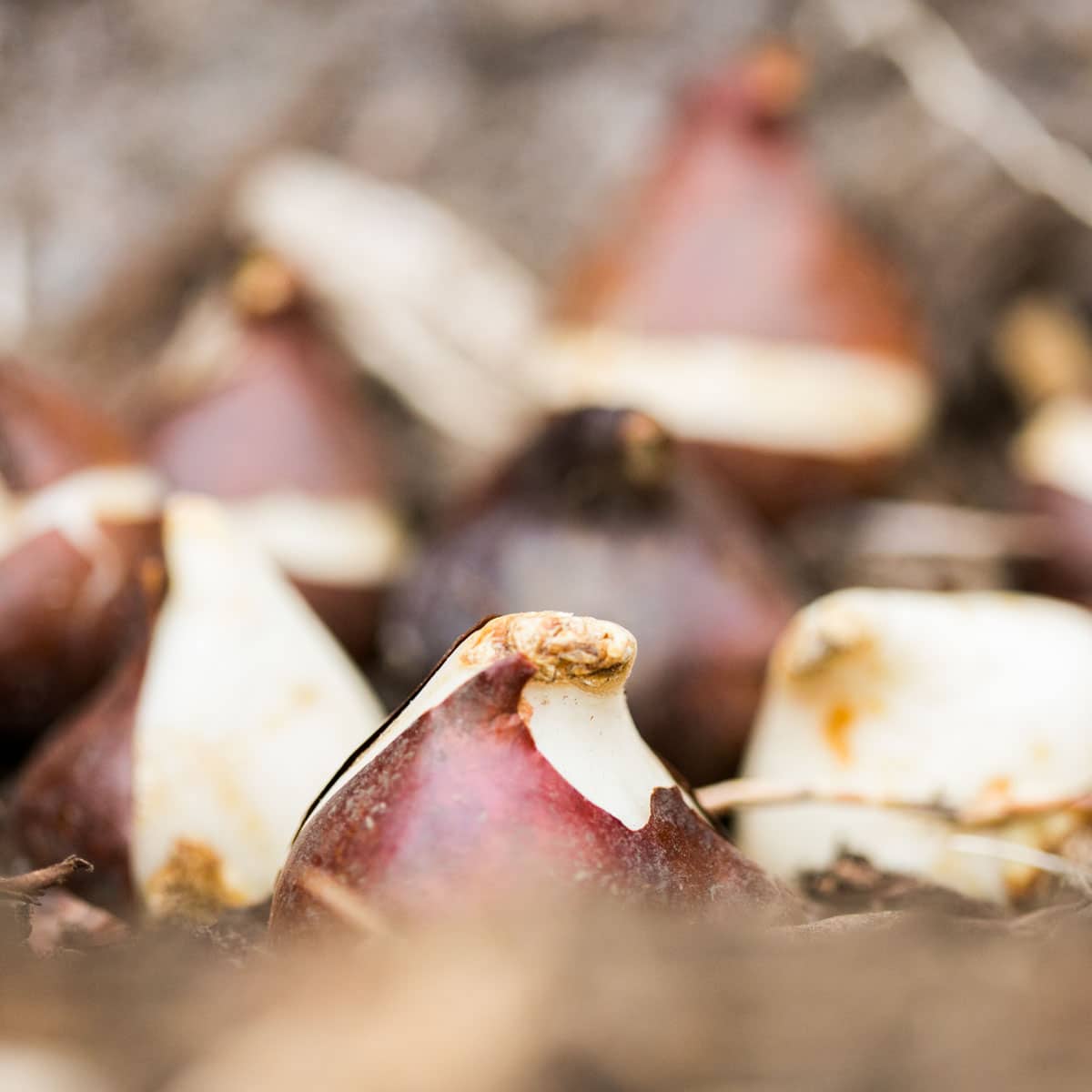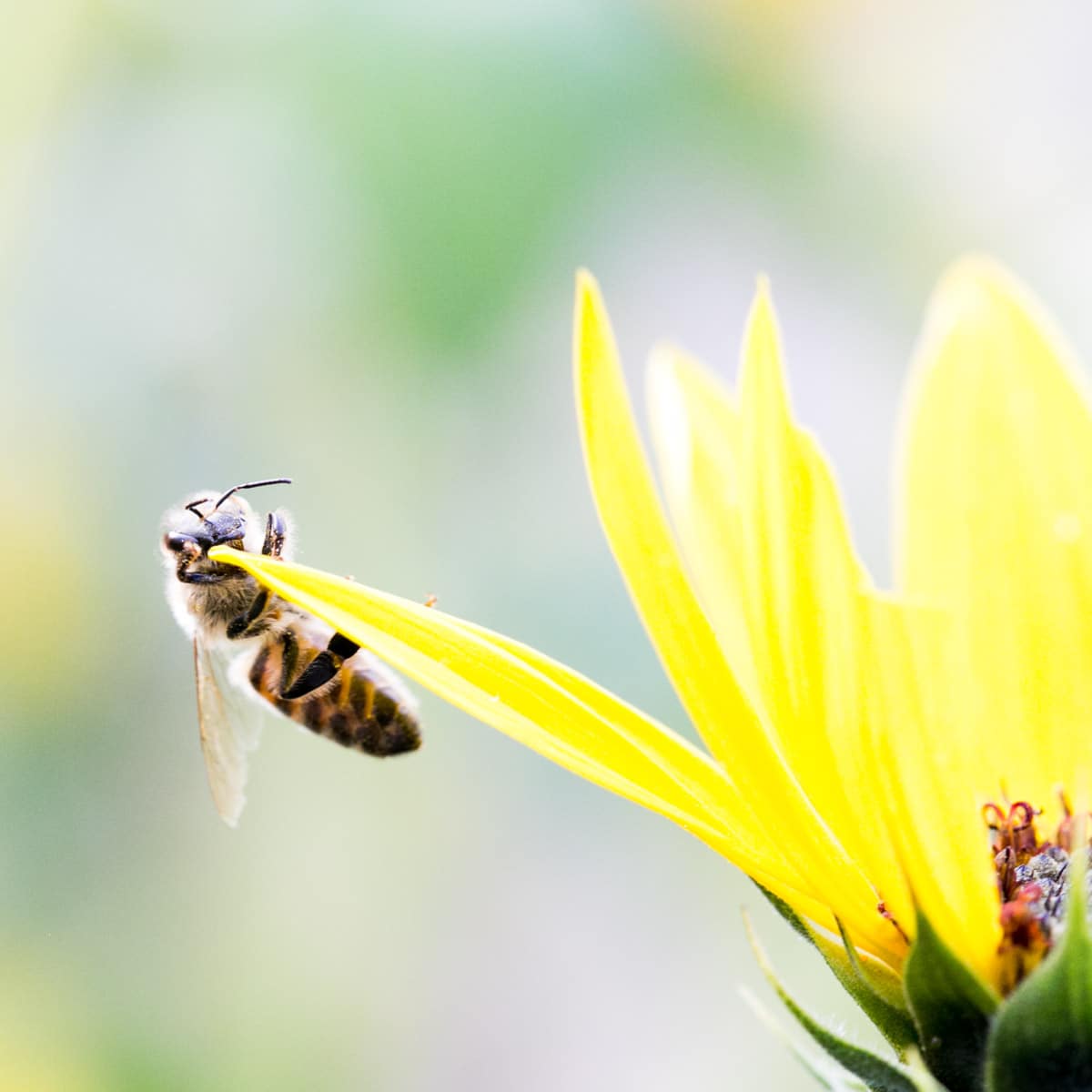How To Grow And Care For Dahlias In Your Own Flower Garden
This is the complete guide to growing and caring for dahlia flowers!
Dahlias are a spectacular cutting flower that come in a rainbow of colors and bloom endlessly. They are a favorite to florists and home growers alike.
These perennials are easy to grow and care for, though specific varieties may need a little extra love and support.
This guide will walk you through everything you need to know to start growing your own dahlia flowers.
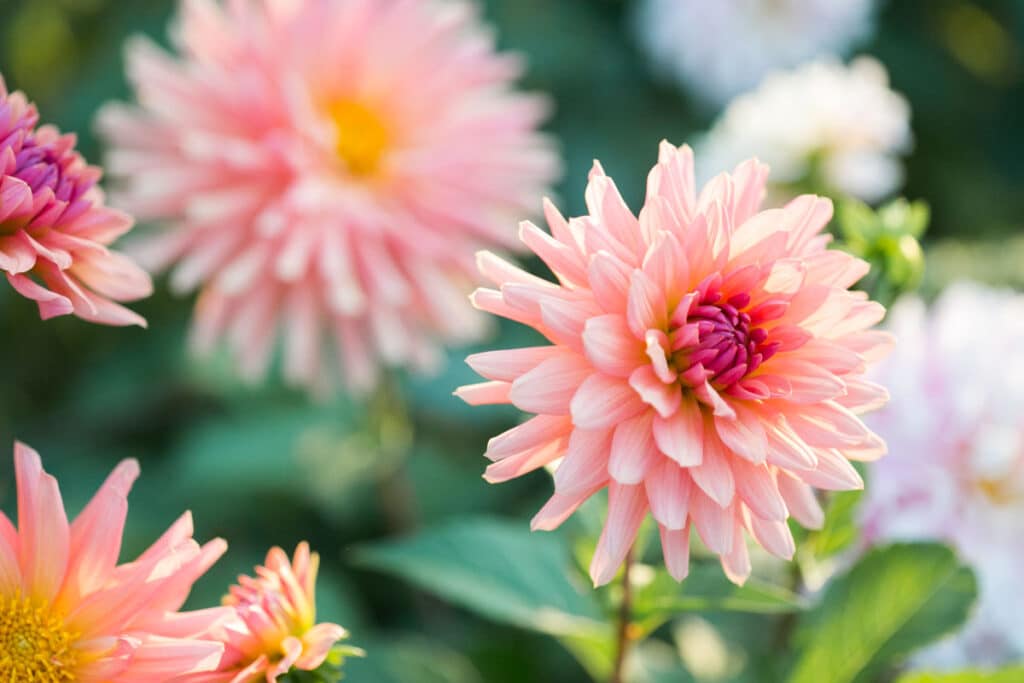
In just a few months you can feature a beautiful home-grown dahlia arrangement bursting with color adorning your own table.
About
Dahlias are native to the higher elevations of Central America and Mexico.
The Spanish stumbled upon the beautiful flowers in the last 1700’s and introduced them to Europe. Since then they’ve spread world wide!
These vibrant flowers thrive in warm areas with lots of moisture. They grow as bushy perennials ranging from 2.5 to 6 feet in height.
These beautiful bloomers have a long blooming season, often up to four months long!

Dahlias come in a wide array of varieties and are classified by their size and color.
Huge dinner plate varieties can grow up to 15 inches, and their tiny cousins wave cheerily at just 2 inches.
These flowers are planted in many areas of the United States, and have become a popular cutting flower. Large dinner plate varieties are often used in wedding bouquets and decor.
This incredible cutting flower is reliably grown as a perennial in zones 8 to 11, and usually grown as an annual in zones 7 and below.
In these colder zones the ubers can be dug up, overwintered and re-planted in the spring.
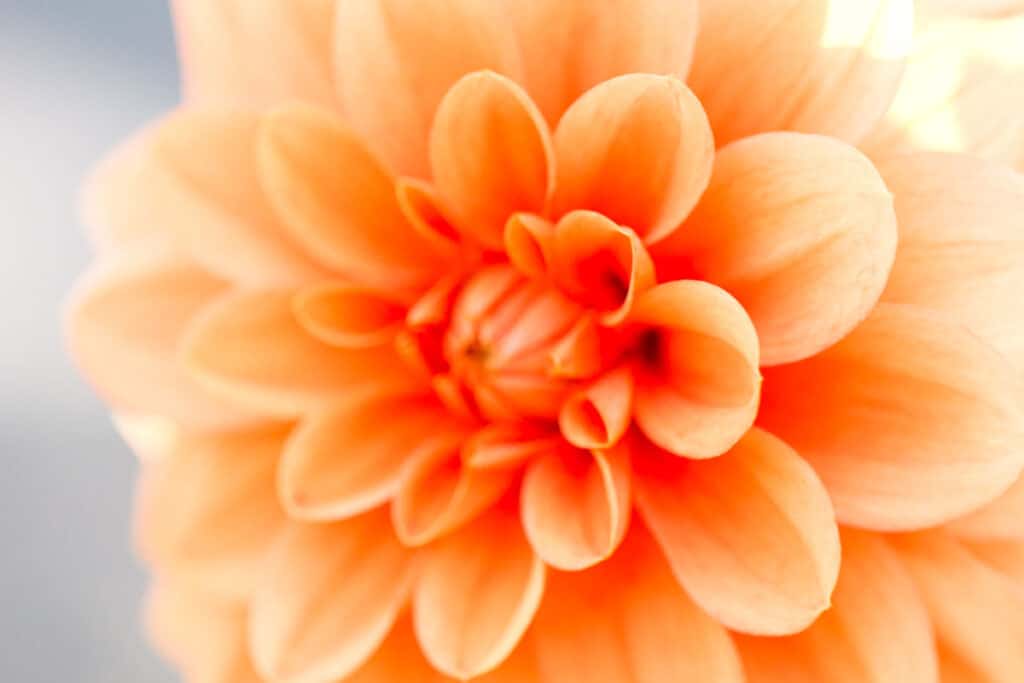
Types
Dahlias are beloved in part because of their magnificent diversity.
There are over 50,000 registered cultivars worldwide! It is hard to keep track of the many vibrant and diverse dahlias.
They are classified by the American Dahlia Society into 6 sizes, 20 forms, and 17 colors.

Growing Zones
Dahlias are considered a tender perennial because they can be grown as a perennial in warmer zones with mild winters. In zones with harsh winter temps they are grown as annuals.
These versatile flowers can be grown as a perennial in Zones 8 and above. They are grown as annuals in zones 7 or below, but their tubers can be dug up, stored and re planted in late spring when the weather warms.
Make sure to research your specific zone before planting so you can be prepared on how to care for them in your climate.
You can read our guide on how to overwinter dahlias here.
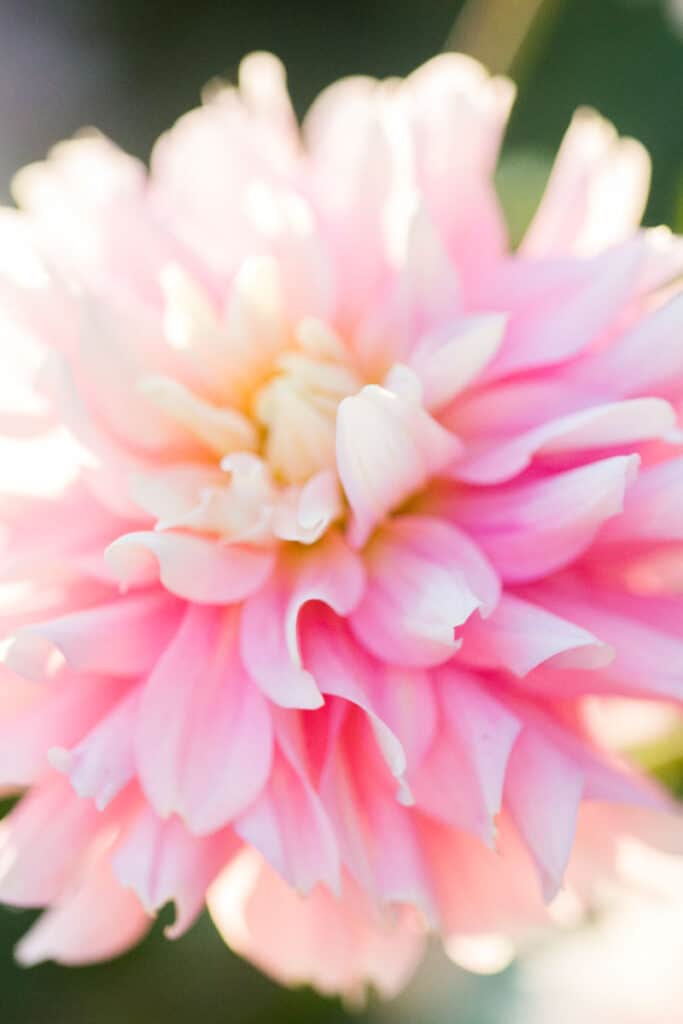
Growing Tips
These lovely flowers are easy to grow, but a few basic rules must be followed to keep them happy and allow them to thrive!
You will need to consider soil, planting time, light, water and fertilizer.
Soil
Dahlias are heavy feeders and need rich soil and good drainage. A loose soil that is fertile and healthy will result in thriving plants.
If your soil does not have these qualities, you can easily add soil amendments and improve drainage with just a few simple additions: compost and sand.
Adding sand will help break up heavy soil and increase drainage.
A good compost mixed into the soil will boost the nutrient quality and help your plants thrive. Lots of organic matter will also assist in drainage.
The pH of the soil should be slightly acidic, between 6.5 and 7.
If needed, consider building raised beds for your plants and filling them with rich soil, compost mix, and sand.
Light
Dahlias crave full sun! They need to be planted in an area that gets 6 to 8 hours of full sunlight, though they can tolerate some dappled shade in the afternoon.
While these plants enjoy lots of sun, avoid planting them in a very hot environment, such as up against a southern facing wall.
If you plant dahlias in a shady spot without enough sunlight they will get leggy while reaching for the light, and their ability to bloom will be stifled resulting in far fewer flowers.
Fertilizer

Dahlias can benefit from a low nitrogen, higher phosphorous fertilizer. This is often referred to as bloom food, because it encourages lush and full flower blooms.
Fertilize once when planting and continue fertilizing once every 3 to 4 weeks.
Get our full guide to the best dahlia fertilizers here!
Spacing
Giving your dahlia plant the right amount of space will prevent diseases like powdery mildew and allow each plant to grow to it’s potential.
Give each plant about 3 feet on either side to grow to it’s full potential.
When planting in rows, you can get away with tucking your dahlias in a little tighter, about 2 rows per 3 feet.
Water
Consistent, even watering is essential, so water dahlia plants deeply once a week. During the hottest days of the summer, increase watering to every 2 to 3 days.
Drip irrigation is ideal because it directly waters the roots of the plants but keeps the foliage dry and moisture free.
When watering by hand, be sure to deeply water once to twice a week, and more frequently during intense, hot weather.
Here are a few key tips for watering:
- To prevent over watering and rotting your dahlia tuber, wait until the green shoots from the tuber appear above the soil to start a watering routine.
- Add a thick layer of mulch around the plants when they are young to help keep in moisture during hot days
- Consider drip irrigation
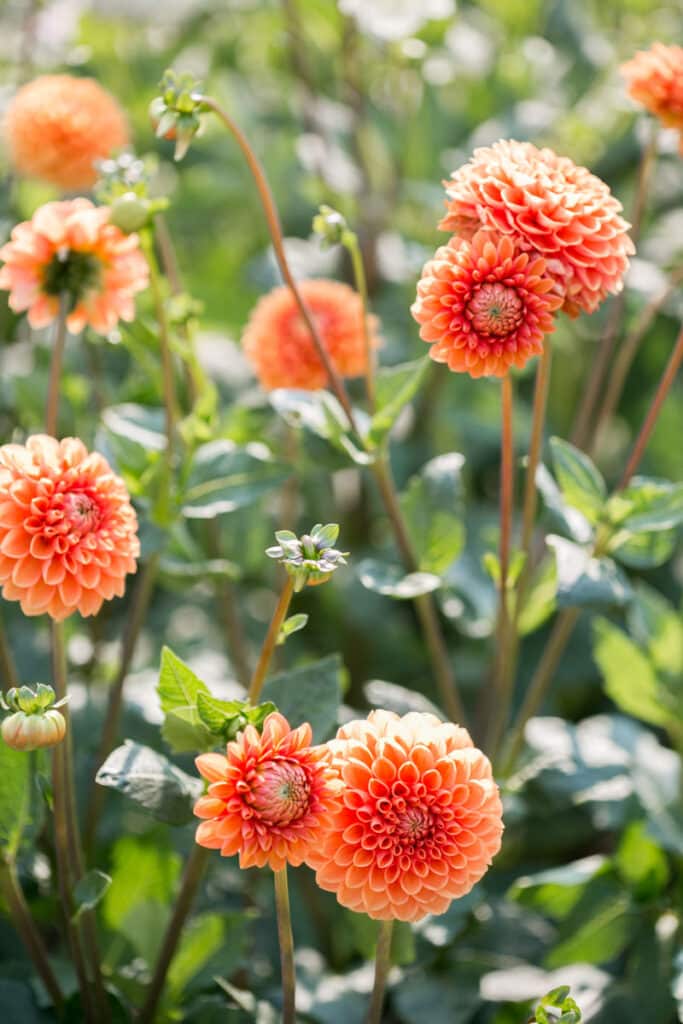
What Is A Tuber?
The dahlia tuber is the root of the plant that contains the energy, water and nutrition for the plant to grow. Dahlia tubers are sometimes inaccurately referred to as dahlia bulbs.
Just like the flowers, dahlia tubers are incredibly diverse. Some are long and skinny, some are round and fat, and some produce a lot of additional tubers while others may only add a few small additional tubers.
How To Plant
Dahlias are most commonly planted from tubers in the spring. Planting is straight forward and easy. As mentioned above, you will want to wait until all danger of frost has passed before planting.
Identify a full fun location and amend soil with nutrients and fertilizer as needed, then follow these tips for planting.
Choose Healthy Tubers
A healthy tuber will have three in distinct parts: the eyes, neck, and body. Make sure the neck is not broken and there is no rot on the tuber before planting.
Dig Hole Or Trench
If you are planting many tubers, you may want to dig a trench to plant them. More commonly, they are planted in individual holes.
Dig deep enough to plant the tuber about 6 inches deep. Make sure the growing eye is pointed up, then cover with soil and mark the area with the type of dahlia planted and date (don’t forget this essential step). You want about 2 to 3 inches of soil to cover the top of the dahlia tuber.
Keep an eye on your dahlias, but wait to prevent watering until shoots come up through the ground. At this point, keep a sharp lookout for slugs and snails.
When To Plant
Plant outside only after all danger of frost has passed. These plants are very cold sensitive and will die in frosts.
The best time to plant is in the spring – if planted in the fall you can risk tubers rotting over winter.
Check your zone to find the last frost date and be sure to plant your dahlia tubers several weeks after for best results.
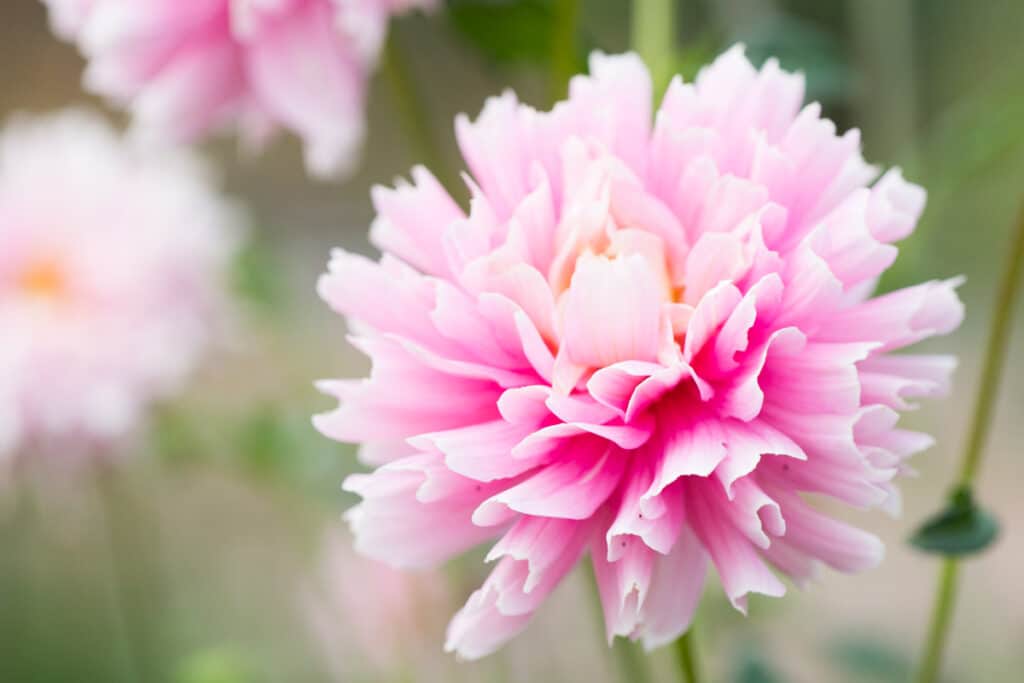
Pinching
Pinching is one of those gardener’s secrets everyone needs to know and practice!
To “pinch” a dahlia plant means to simply pinch or cut off the center stalk when the dahlia plant is 8-12 inches tall. You’ll find the top sprout and cut it off in the center, between the two leaves.
You can find a wonderful video tutorial for pinching dahlias here.
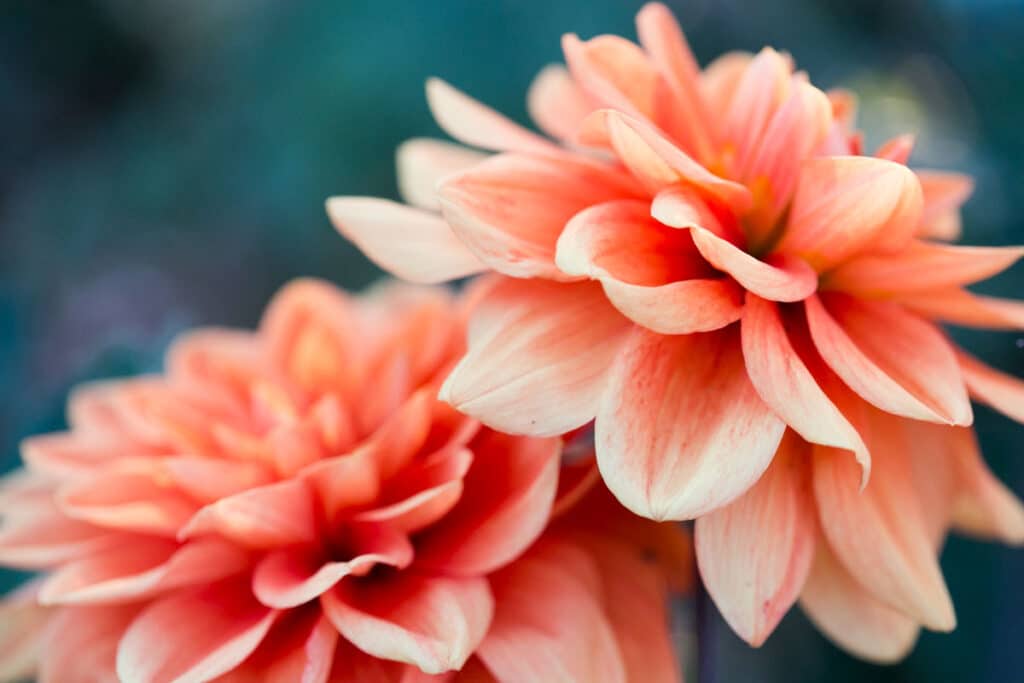
Staking
Healthy dahlias that are well fed and watered will grow into large, thriving plants. When they become strong and healthy they will need significant support in the form of staking.
Smaller dahlia varieties, less than 2 feet tall, typically do not need support. But wind and rain can be particularly brutal in knocking out taller plants.
It is important to start staking early so that you have the support in place as the plant grows, and you are not trying to wrangle blossoms onto a new support system.
Pound stakes into the ground and use twine to tie them as they grow. Or, tie them to an existing fence.
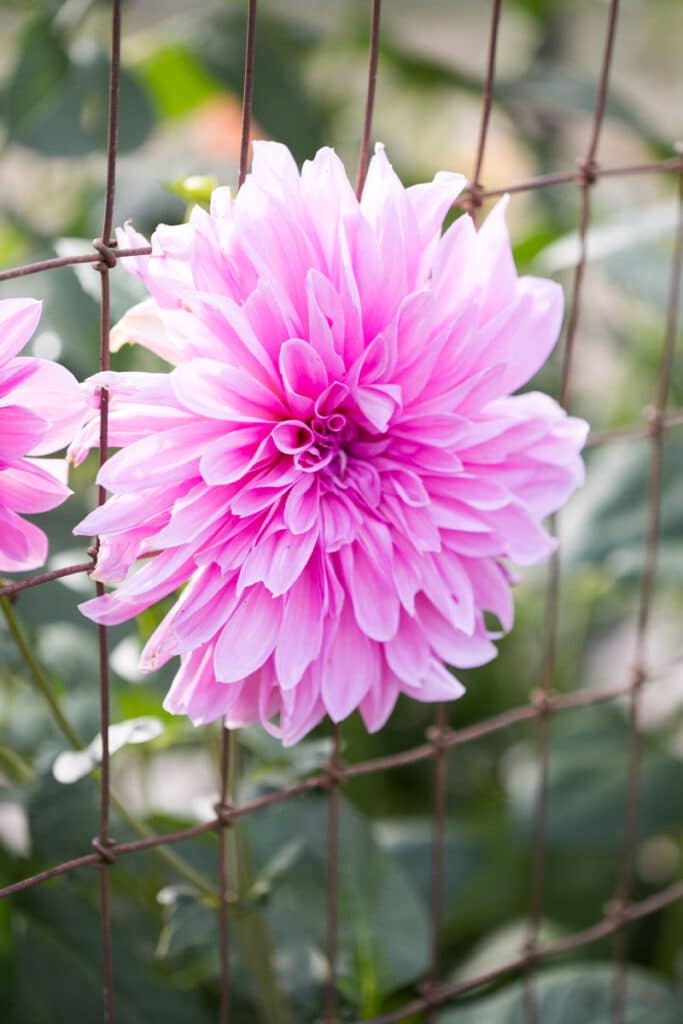
Bloom Time
In most climates, dahlias begin blooming in mid summer and continue to bloom well into fall, typically mid July through late October.
You really get your bang for your buck with this plant-one dahlia plant can produce hundreds of blooms in a season.
These are a cut and come again flower, and they will continue to thrive and bloom all summer long with proper deadheading and the right amount of nutrients and sunlight.
Removing Spent Dahlias For More Blooms
Deadheading dahlias has multiple benefits. Removing spent blooms will allow the plant to put it’s energy into new blooms, instead of creating seeds.
Regularly deadheading will also encourage new flower buds to emerge all summer long.
Read our tutorial about the right way to deadhead dahlias here.

Pests
Dahlias are susceptible to several different kinds of pests:
Slugs and Snails
Slugs and snails particularly enjoy munching on the tenders shoots young plants. The moist rains of springtime increase slug and snail activity.
To deter slugs and snails, we recommend using Sluggo, which is very effective and safe to use around kids and pets.
Insects
Earwigs are famous for their appetite for dahlia petals. They love to chomp up and destroy otherwise impeccable flowers.
Food grade diatomaceous earth sprinkled throughout the garden can prevent slugs from dining on your dahlias (dry environments only). Once they have already infected a plant, Sluggo Plus is an effective way to kill earwigs.
Aphids
There are two ways to deter aphids. As a preventative measure, regularly releasing ladybugs into the dahlia garden will keep the aphid population under control. Once aphids appear, use organic insecticidal soap to control them.

Diseases
Like all flowers, dahlias are susceptible to their share of diseases. They can fall prey to bacterial, viral and fungal disease. The best way to prevent disease is to keep the plant healthy, with the right nutrients and appropriate amount of water.
Viruses
Yellow streaking is a common sign of viruses. Remove any spots, streaking or discolored areas on the leaves of the plant. Be sure to destroy any part of the diseased plant and keep the removed parts away from other plants.
Fungus
Powdery mildew, leaf spot and smut are common fungal diseases that are caused by overcrowding and over watering. To prevent fungal problems give your planty of space and air flow and don’t overwater.
Bacterial Disease
Crown gall is a common bacterial disease that can affect the tubers. Bumpy white warts form all over the outside of the tuber and cause stunted growth and decay. Unfortunately, there is no treatment for gall.

Weeds
Weeds can easily overwhelm a dahlia bed and leach essential nutrients from the soil. This can leave your plant undernourished and suffocate the plant.
The best way to approach weeds is to start early! Clear all weeds and their from the flower site before planting.
After planting your tubers, put down a layer of mulch and bark to prevent and suffocate weeds. Regularly check on your flower bed and use a hoe to remove any lurking weeds.
How To Harvest Cut Flowers
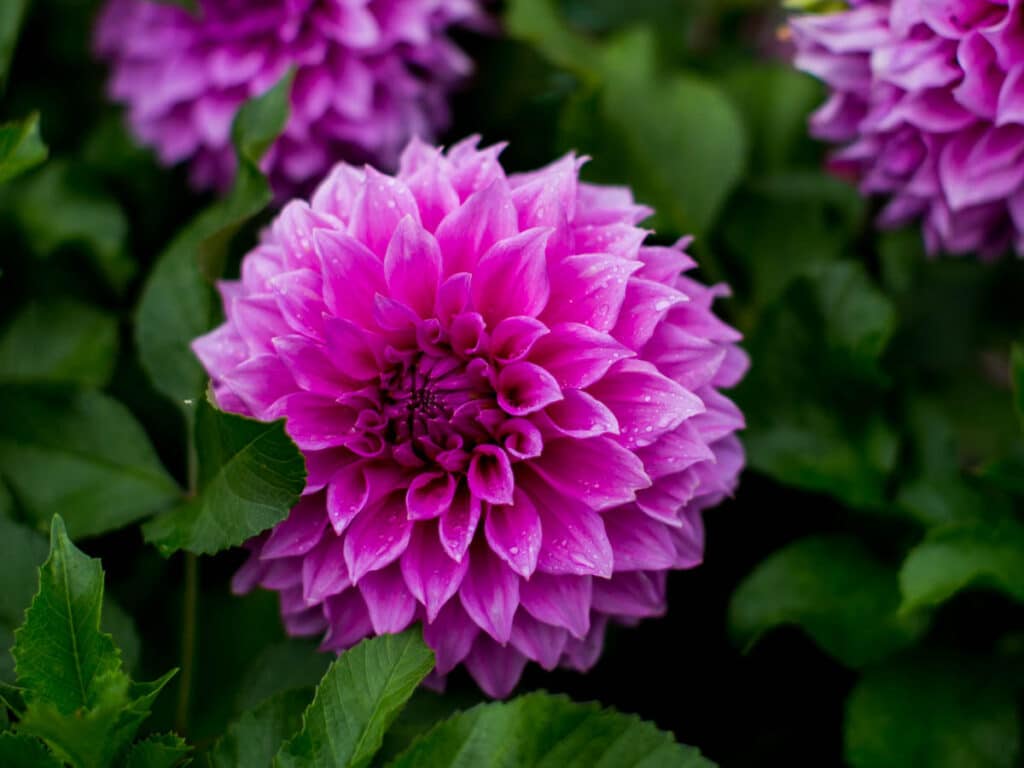
Dahlias are widely grown as cut flowers due to their huge variety and brilliant color.
A single dahlia flower by itself can make quite a statement, but many flowers together make a sophisticated and stunning arrangement.
For best results, harvest flowers early in the morning before the heat of the day kicks in. Use a clean pair of flower clippers. Cut stems as far down as possible, and immediately place in cool water.
Set your flower vase in a cool area out of sunlight.
The best dahlias to pick have just opened, with firm strong petals. If you cut flowers that have already showed signed of wilting you will end up with petals all over the counter in short order!
How Long Do Cut Dahlia Flowers Last?
Harvested dahlia flowers last 3 to 5 days.
This is not a long lasting cut flower, sadly. (I guess they make up for that with how many blooms they produce!).
They wilt more quickly than many flowers, but their life can be extended by cutting at the right time of day and keeping them out of heat.
Popular Dahlias For Cut Flowers
Dahlias make wonderful cut flowers for bouquets and arrangements. Keep in mind they have a very short vase life compared to many flowers, however they bloom so well that you can create bouquets all summer long!
Some of the most important considerations for cut flowers are the length and strength of the stem, petals that hold up for a longer period time, and the vase life.
While all dahlia flowers tend to last for about 3 to 5 days in a vase, ball varieties hold up the longest because the petals are more compact.
Some of our favoritie varieties for vases: Clearview Peachy, Ferncliff Copper, Peaches N Cream, Nijinksy, and Marshmallow are some of the best varieties for cut flower use.
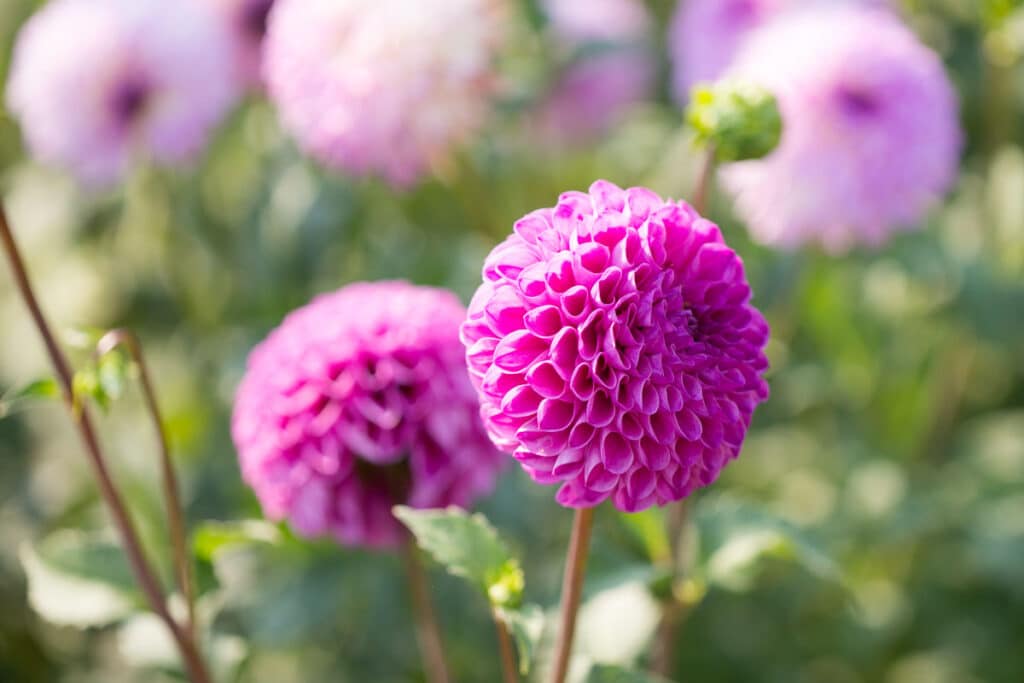
Growing Dahlias In Pots + Containers
Small, compact dahlia varieties often do very well in pots and containers.
We would recommend you do not plant large dahlia varieties with heavy heads in containers.
There are a few benefits to growing dahlias in pots. They can be easily overwintered as you can pull your container in from the cold during the winter months.
It is also easier to keep slugs and snails away from your plants.
Dahlias grown in pots need to be watered more regularly, especially in hot weather. They also need to be fertilized more frequently because thee fertilizer drains from the soil more quickly.
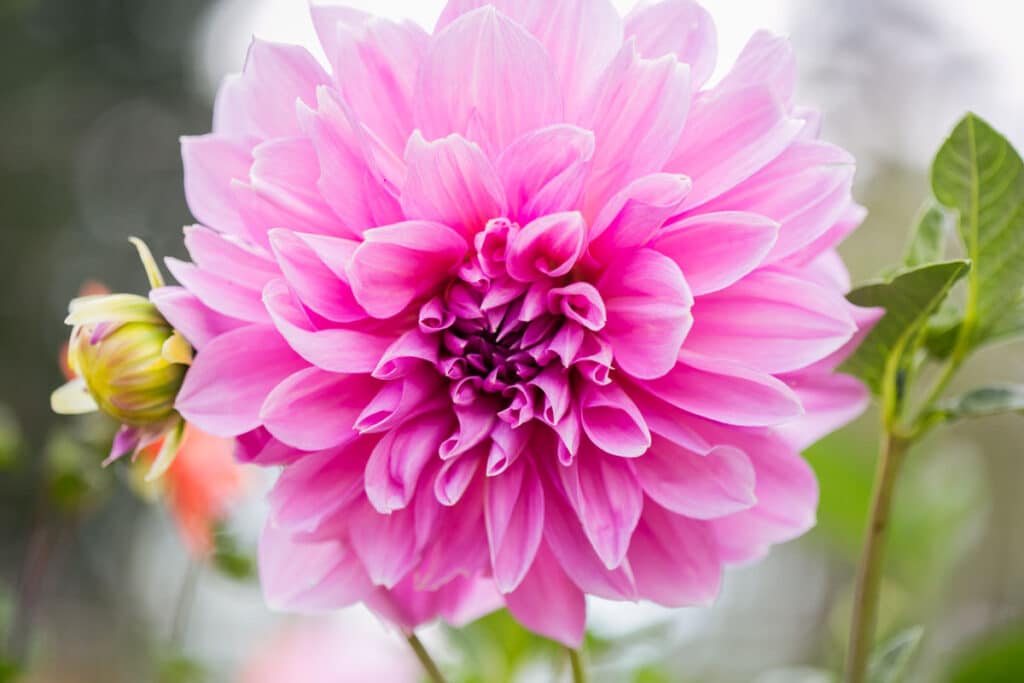
Do Dahlia Flowers Bloom The First Year They Are Planted?
Yes, dahlias planted from a tuber will bloom the first season they are planted.
Are Dahlias Easy To Grow?
Yes, dahlia flowers are easy to grow- with a few exceptions.
Dwarf dahlias and established dahlias grown in pots are very easy to grow. Dahlia varieties with larger flower heads are a bit more challenging. These dinner plate dahlias require extra staking to ensure that their heads don’t fall over and break the entire plant.
Your specific growing zone also affects how easy or challenging dahlia flowers will be to grow.
If you live in a zone that requires digging up dahlia tubers, more elbow grease will be involved in growing them as annuals.
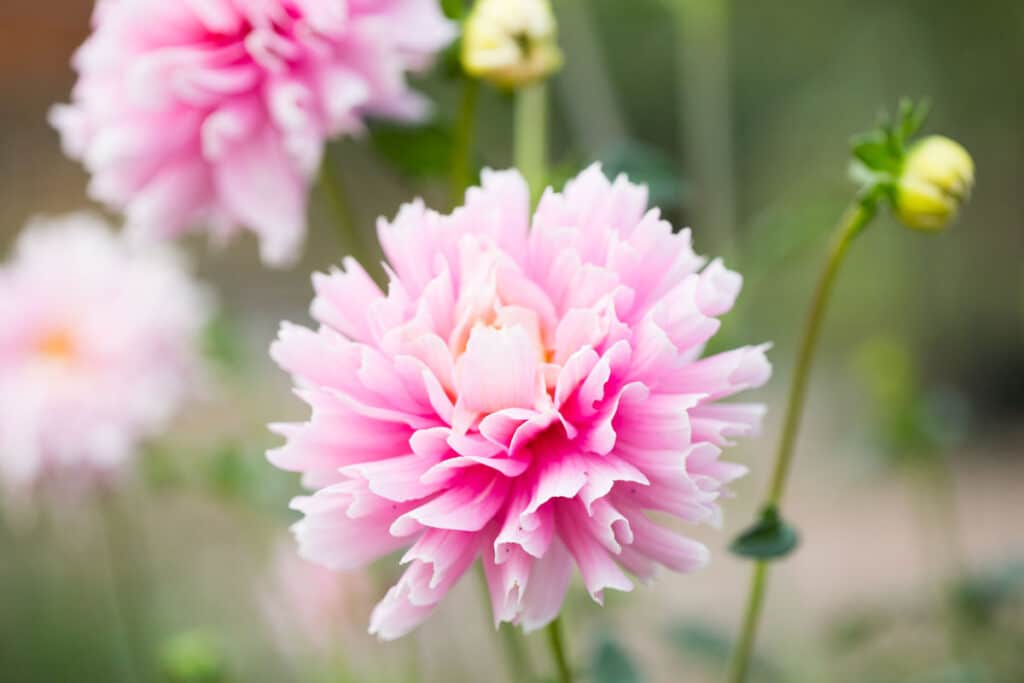
What Month Do You Plant Dahlias?
Dahlia tubers are typically planted in late May to early June. This will be dependent on where you live and the current climate. A good rule of thumb many seasoned gardeners follow is to plant your dahlia tubers at the same time as planting tomato plants.
How Long Do Dahlia Plants Last?
With fertile soil, proper water and consistent deadheading, dahlia plants can flower for up to 4 months. This is dependent on the zone and current weather you are experiencing within your zone.
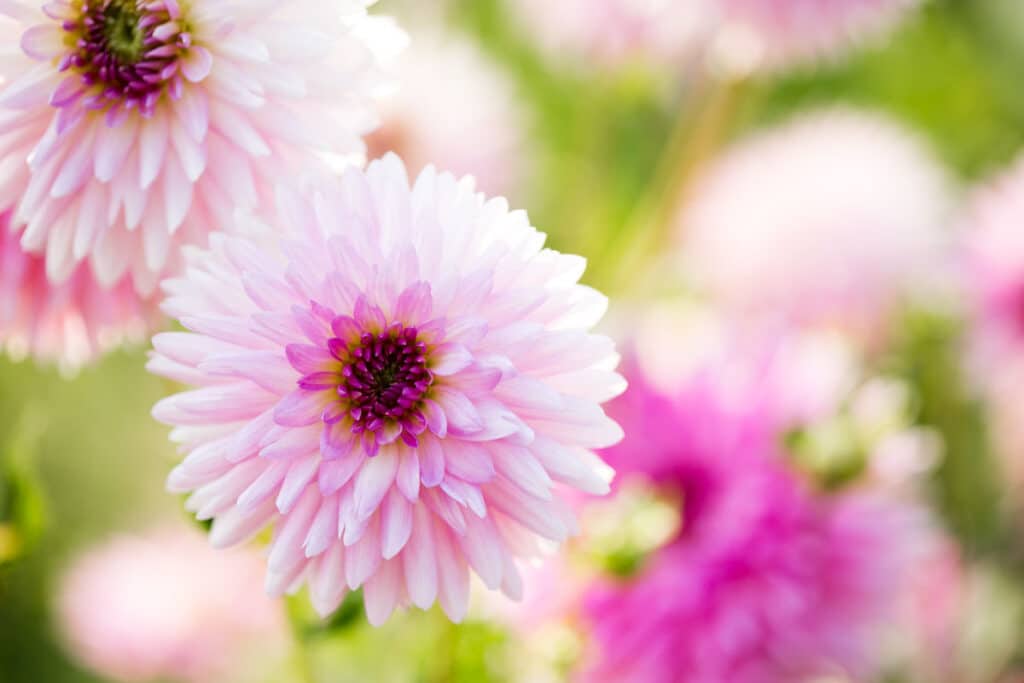
Do Tubers Multiply?
Yes, dahlias multiply each year. It is important to dig up and divide tubers every other year because the tubers multiply every year. This increases your number of plants, so be sure to dig, divide, and give away!



